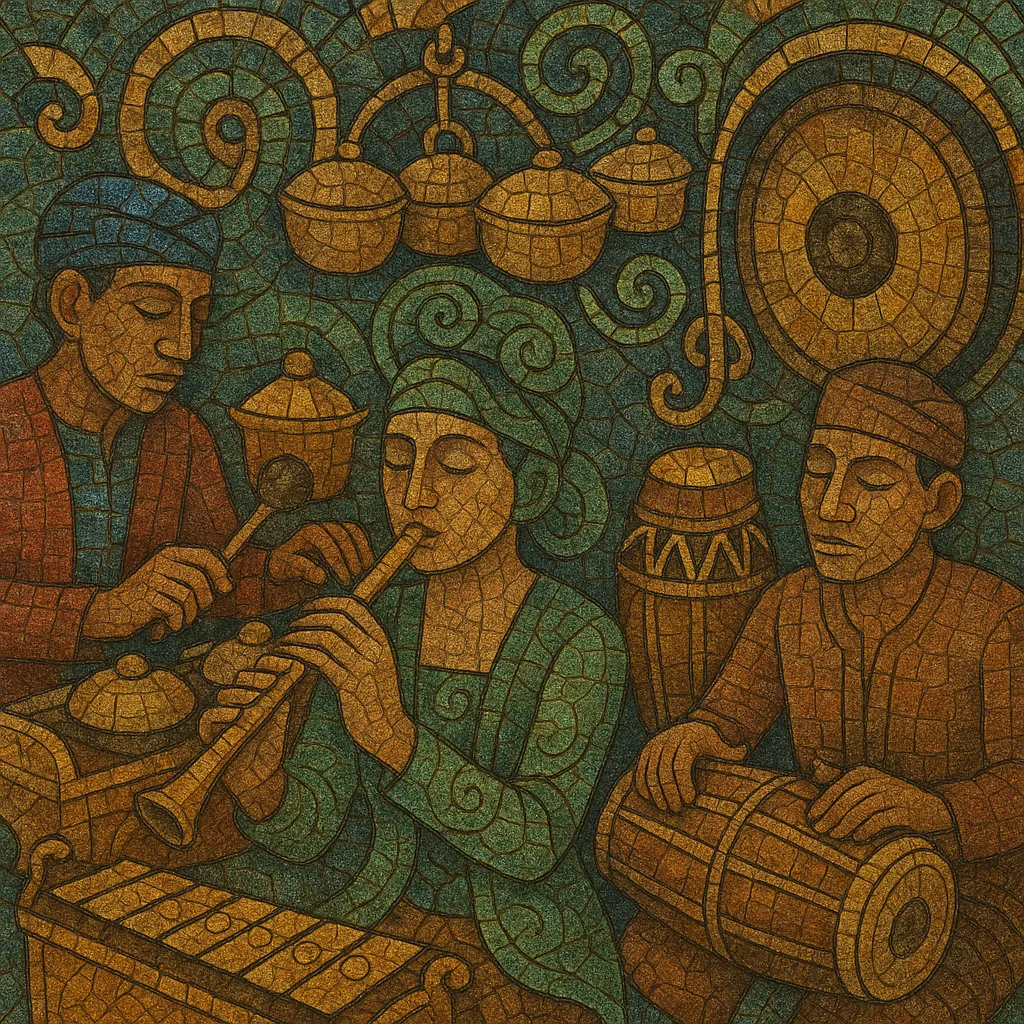Gamelan salendro is a Sundanese gamelan tradition from West Java, Indonesia, named after the five-tone salendro (saléndro) tuning system. Its pentatonic scale is characterized by near‑equidistant intervals, producing a bright, open sonority distinct from the seven-tone pelog of many Central Javanese sets or the degung scale used in other Sundanese ensembles.
The ensemble typically supports wayang golek (rod-puppet theater), dance, and social events. Instruments include metallophones (saron family), hanging and kettle gongs (goong, kempul, jengglong, kenong/kolénang), the bonang/kolénang, bamboo flute (suling), bowed lute (rebab), timekeeping and coloristic instruments (rincik, kecrék), and the double-headed drum (kendang) that leads tempo, transitions, and dance gesture.
Musically, gamelan salendro features cyclic colotomic structures articulated by the gong family, with interlocking (imbal) and layered elaborations around a core melody. Vocals by a sinden (solo singer) and/or chorus are common, delivering Sundanese poetry and stylized text to shape mood and narrative.
Salendro refers to a pentatonic tuning heard in West Java for centuries, with roots predating Islamization and colonial rule. As courtly and village arts coalesced in the 18th–19th centuries, a distinct Sundanese ensemble practice using the salendro scale formed to accompany ritual, social dance, and especially wayang golek (rod‑puppet theater).
By the 1800s, standardized colotomic cycles, instrument roles, and repertory for theater and dance were solidified. The kendang took a prominent role in cueing puppetry scenes and dance movement, while suling and rebab provided lyrical elaboration over metallophones and gongs. Early 20th‑century radio and archival recordings (notably in Bandung) helped codify characteristic pieces and playing styles.
After Indonesian independence, urban cultural institutions, radio orchestras, and arts schools promoted Sundanese traditions. Gamelan salendro remained central to wayang golek and performance troupes. From the late 1970s onward, popular dance forms such as jaipongan drew on salendro‑tuned instrumentation and rhythmic energy, bringing the sonority into broader popular and stage contexts.
Today, gamelan salendro thrives in West Java in ceremonial life, community troupes, and professional theaters. Ensembles collaborate with choreographers, dalang (puppeteers), and vocalists, while educators and researchers document technique and repertory. The style also appears in cross‑cultural and contemporary works, retaining its distinctive pentatonic brightness, cyclical form, and kendang-led dynamism.
Work in the Sundanese salendro (saléndro) pentatonic scale. Tune instruments to a cohesive local set rather than equal temperament, and shape modal color (patet/pathet) through characteristic cadences, emphasized tones, and register.
Use a core gamelan salendro ensemble: saron family (peking/panerus, barung), jengglong (low kettle gongs), kenong/kolénang and bonang/kolénang (kettle-gong sets), large goong and kempul for colotomic markers, suling (bamboo flute), rebab (bowed lute), rincik/kecrék for time coloration, and kendang leading the ensemble. A sinden (solo vocalist) or small chorus may deliver Sundanese text.
Compose in cyclical gong structures (gongan) subdivided by kenongan and kempul strokes. Let the kendang articulate tempo, transitions (e.g., scene changes in wayang golek), and dance accents. Integrate dynamic shifts and tempo rubato within the cycle while maintaining clear colotomic punctuation.
Outline a core melody (lagu) in mid‑register metallophones, then add elaborating layers: interlocking (imbal) patterns on saron/bonang, sustained or ornamented lines on suling and rebab, and cadential preparations into gong points. Employ antiphony between instruments and voice, with the sinden shaping phrase contour and poetic emphasis.
When using vocals, set Sundanese poetry or formulaic lyrics appropriate to wayang/dance contexts. Match syllabic stress and melisma to the scale’s idiom. Balance bright, celebratory pieces with more reflective numbers while preserving the salendro timbral shine.


